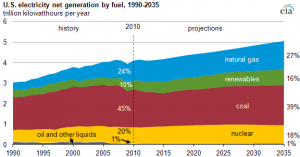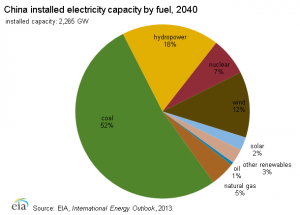Earlier today, the United States and China announced new targets to reduce carbon pollution. The agreement, which the White House published on its website, sets new goals for both countries.
President Obama plans to cut U.S. carbon pollution by 26-28% below 2005 levels by 2025, and China’s President Xi Jinping said China is committed to ensuring that its CO2 emissions peak around 2030 or earlier, if possible, and to boost its share of non-fossil fuel energy to around 20% by 2030 as well. To achieve this goal of 20% zero-emission sources in primary energy, China will have to deploy an additional 800-1000 gigawatts of zero-emission generation to reach its goal, according to the White House.
Historically, the main sources of zero-emission generation have been nuclear power plants and hydroelectric generation. These zero carbon emitting sources are able to provide baseload power, defined as uninterrupted 24/7 generation of the electricity needed to power large industrial economies like the U.S., Canada, China, Japan, Europe and many others. Coal fired power plants and natural gas fired power plants are the main sources of electricity in many countries. The migration from coal to natural gas-fired electrical generation has been driven by carbon reduction initiatives. Natural gas-fired generation plants generally produce about half the amount of carbon as coal-fired plants.
Wind and solar generation provide small additions of zero-carbon electricity to the grid but they aren’t capable of generating 24/7 baseload power. Their operations are dependent on weather conditions and, in the case of solar, limited to daytime power generation only. Even though they are extremely efficient, low cost power generators, nuclear power plants fell out of favor around the globe following Japan’s Fukushima disaster in 2011, but many Asian countries, including China, have large numbers of nuclear power plants in development.
The World Nuclear Association reports that China has 22 nuclear power reactors in operation, 26 under construction, and more about to start construction. Additional reactors on the drawing boards would allow China to achieve a three-fold increase in nuclear capacity to 58 GWe by 2020, 150 GWe by 2030, and much more by 2050. Nuclear is one path toward zero carbon but the plants are extremely expensive to design, permit and build.
Today’s move represents one of the biggest steps yet taken in combating climate change to date. The agreement is the first time President Xi has announced his intention to peak Chinese CO2 emissions.
In order to reach these goals, the U.S. and China agreed to:
- expand joint clean energy research and development,
- advance major carbon capture, use and storage demonstrations,
- enhance cooperation on hydroflurocarbons,
- launch a climate-smart/low-carbon cities initiative,
- promote trade in green goods.
The U.S. will undertake a number of additional pilot programs, feasibility studies, and other collaborative efforts to promote China’s energy efficiency and renewable energy goals, according to a separate release from the White House.
Carbon Reduction at What Cost?
Many are touting the agreement as a cause for celebration, but some Republican politicians are worried that the cost to the economy might be too great. House Speaker John Boehner was quoted by CNN as saying that the agreement “is the latest example of the president’s crusade against affordable, reliable energy that is already hurting jobs and squeezing middle-class families.” Senate Minority Leader Mitch McConnell, who hails from coal-rich Kentucky, said, “[the agreement] requires the Chinese to do nothing at all for 16 years while these carbon emission regulations are creating havoc in my state and other states around the country.”
The White House said the ultimate target is to “achieve deep, economy-wide reductions on the order of 80% by 2050,” a senior Obama administration official told CNN in a separate article. The official commented that domestic politics could be a challenge, but that it would not be an insurmountable obstacle. He said, “Congress may try to stop us, but we believe that with control of Congress changing hands we can proceed with the authority we already have.”
Important disclosures: The information provided herein is believed to be reliable; however, EnerCom, Inc. makes no representation or warranty as to its completeness or accuracy. EnerCom’s conclusions are based upon information gathered from sources deemed to be reliable. This note is not intended as an offer or solicitation for the purchase or sale of any security or financial instrument of any company mentioned in this note. This note was prepared for general circulation and does not provide investment recommendations specific to individual investors. All readers of the note must make their own investment decisions based upon their specific investment objectives and financial situation utilizing their own financial advisors as they deem necessary. Investors should consider a company’s entire financial and operational structure in making any investment decisions. Past performance of any company discussed in this note should not be taken as an indication or guarantee of future results. EnerCom is a multi-disciplined management consulting services firm that regularly intends to seek business, or currently may be undertaking business, with companies covered on Oil & Gas 360®, and thereby seeks to receive compensation from these companies for its services. In addition, EnerCom, or its principals or employees, may have an economic interest in any of these companies. As a result, readers of EnerCom’s Oil & Gas 360® should be aware that the firm may have a conflict of interest that could affect the objectivity of this note. The company or companies covered in this note did not review the note prior to publication. EnerCom, or its principals or employees, may have an economic interest in any of the companies covered in this report or on Oil & Gas 360®. As a result, readers of EnerCom’s reports or Oil & Gas 360® should be aware that the firm may have a conflict of interest that could affect the objectivity of this report.


